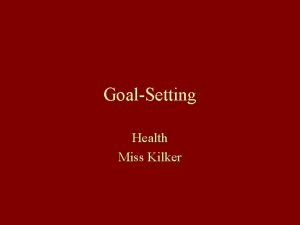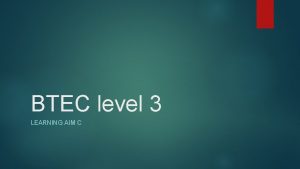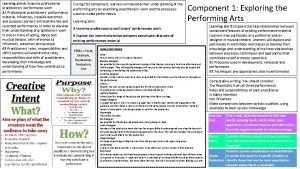Learning aim A Examine professional practitioners performance work




- Slides: 4

Learning aim A: Examine professional practitioners’ performance work A 1 Professional practitioners’ performance material, influences, creative outcomes and purpose Learners will examine live and recorded performances in order to develop their understanding of practitioners’ work in one or more of acting, dance and musical theatre, with reference to influences, outcomes and purpose. A 2 Practitioners’ roles, responsibilities and skills Learners will examine the roles, responsibilities and skills of practitioners, developing their knowledge and understanding of how they contribute to performance. During this component, learners will develop their understanding of the performing arts by examining practitioners’ work and the processes used to create performance. Learning aims: Component 1: Exploring the Performing Arts A Examine professional practitioners’ performance work B Explore the interrelationships between constituent features of existing performance material. PEEEL = Point, Example, Explanation, Evaluation, Link Roles in the Theatre Actor Person whose role it is to play a character Theatre Manager Responsible for the smooth operational running of theatre, ensuring it functions effectively and within budget. They will typically manage staff, resources and systems and may also be responsible for leading on marketing and publicity activities. Costume Designer Member of the creative team for a show responsible for the clothes worn by the actors throughout the performance. Director Broadly, the role involves being responsible for the overall artistic vision of a production including characterisation, blocking and design. Lighting Designer Professional in charge of the design and plotting of the lights on stage. Puppet designer A puppet designer's role is to create a puppet that is interesting, creative and engaging for the audience and that makes a clear contribution to the performance in terms of narrative, character, mood or atmosphere. Your design needs to work for the production. Playwright The author of a play. Set Designer Responsible for the design and production of everything on stage. Sound Designer Member of the production team who has the responsibility for planning and executing the layout of all sound playback and reinforcement equipment for the show. This role also includes the sourcing of music and sound effects for the production. Stage Manager In charge of backstage calling the cues from the prompt corner and supervising props. Understudy A person who learns another's role in order to be able to act at short notice in their absence. Technicians make sure that theatre equipment is kept in good working order and that all those using or exposed to it are safe. A single technician is sometimes given responsibility for all technical aspects of a theatre or performance, but more often than not, the role is focussed on either lighting or sound. Learning aim B: Explore the interrelationships between constituent features of existing performance material Learners may participate as a performer and/or designer in musical theatre. Learners will explore and participate in workshops and classes to develop their knowledge and understanding of the interrelationships between processes, techniques and approaches that contribute to performance repertoire. B 1 Processes used in development, rehearsal and performance B 2 Techniques and approaches used in performance Comparative writing -You should consider: The Repertoire from all three performances Roles and responsibilities of each practitioner Creative intention Key influences Make comparisons between stylistic qualities, using examples to back up your knowledge

Performance roles Non- Performance roles Actor, Dancer, Singer Choreographer, Director, Writer and Designer. Responsibilities: Rehearsing, Performing, Contributing to the creation and development of performance material, e. g. devising, designing, choreographing, directing, writing o refining performance material and managing self and others. Skills: physical, vocal and music skills used by performers, managing and directing skills used by a choreographer, artistic director, casting director or musical director, communication skills used to liaise, direct and perform by a choreographer, director, actor, designer, dancer or musical theatre performer, creative skills, such as designing set, costume, lighting or sound, writing scripts and composing songs by a playwright or songwriter o organisational skills used to put on a performance by a director or choreographer. A: Examine professional practitioners’ performance work

B 1: Processes used in development, rehearsal and performance Processes, to include: • Responding to stimulus to generate ideas for performance material • Exploring and developing ideas to develop material • Discussion with performers • Setting tasks for performers o sharing ideas and intentions teaching material to performers • Developing performance material • Organising and running rehearsals • Refining and adjusting material to make improvements providing notes and/or feedback on improvements. B 2 Techniques and approaches used in performance Techniques such as: • Rehearsal • Production • Technical rehearsal • Dress rehearsal • Performance • Post-performance evaluation/review. B: Explore the interrelationships between constituent features of existing performance material

Component 1 Task List Learning Aim A • Research into three Performing Arts Products of different styles. We have explored 5 Soldiers, Blood Brothers and The Lion King • Discuss the style of the performance piece (eg: rock, opera, jukebox, review, book) what are its main features? • What are the stylistic qualities and what is their purpose or influence? (themes, purpose, influence, production elements) • How does that style effect the way the performers have to work and skills they need? • What other features does that piece include, how are they used and what is the effect? (comment on acting, music, dance, costume, lighting, staging and props) • What practical work have you undertake? Learning Aim B • What are the roles, responsibilities and skills needed for a director, choreographer and performer? What happens in the rehearsal process? How do they work together to created the finished product? • Write an essay to compare and contrast the three musicals. Discuss the styles, features and process used in each style and how would the overall productions be different? • Write a piece of extended writing to summaries how practitioners contribute to the performance process and how their roles and responsibilities differ depending on the performance, style and outcome. Use specific examples from the performance in all written elements.







